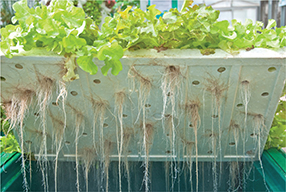6.2 Covalent Bonding
Reading Focus
Key Concepts
 How are atoms held together in a covalent bond?
How are atoms held together in a covalent bond? What happens when atoms don't share electrons equally?
What happens when atoms don't share electrons equally? What factors determine whether a molecule is polar?
What factors determine whether a molecule is polar? How do attractions between polar molecules compare to attractions between nonpolar molecules?
How do attractions between polar molecules compare to attractions between nonpolar molecules?
Vocabulary
covalent bond
molecule
polar covalent bond
Reading Strategy
Relating Text and Visuals Copy the table. As you read, look closely at Figure 9. Complete the table by describing each type of model shown.
Model |
Description |
|---|---|
Electron dot |
a. |
Structural formula |
b. |
Space-filling |
c. |
Electron cloud |
d. |
Plants absorb water through their roots from soil or from a solution containing nutrients, as in Figure 8. Carbon dioxide from the air enters the plants through small openings in their leaves. The plants use the energy from sunlight to convert water and carbon dioxide into a sugar. Energy is stored in the chemical bonds of the sugar.
The elements in sugar are carbon, oxygen, and hydrogen. All three are nonmetals, which have relatively high ionization energies. A transfer of electrons does not tend to occur between nonmetal atoms. So, how are two nonmetals able to form bonds?
Covalent Bonds
You and a friend are participating in a treasure hunt. The rules state that the first person to find all eight items on a list will win a 21-speed bicycle. After about an hour, you have found six of the items on the list and your friend has found the other two. You and your friend have incomplete sets of items. But if you are willing to share your items with your friend, together you will have a complete set of items and qualify for the prize. Of course, you will have to be willing to share the bicycle, too. When nonmetals join together, they display a similar sharing strategy.
Figure 8 When plants are grown in water instead of soil, you can see their roots. Plants absorb water through their roots and carbon dioxide through small openings in their leaves.






